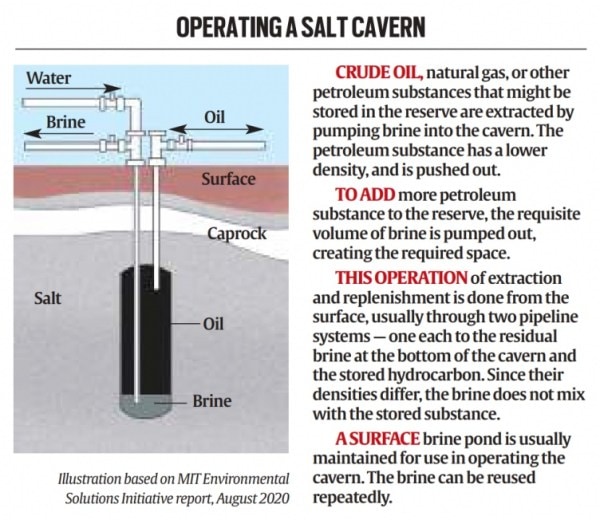Context
-
Government-owned engineering consultancy firm Engineers India (EIL) is studying the prospects and feasibility of developing salt cavern-based strategic oil reserves in Rajasthan, in line with the government’s objective of increasing the country’s strategic oil storage capacity.
Key Details
- If the idea comes to fruition, India could get its first salt cavern-based oil storage facility. The country’s three existing strategic oil storage facilities — at Mangaluru and Padur in Karnataka, and Visakhapatnam in Andhra Pradesh — are made up of excavated rock caverns.

- Countries build strategic crude oil reserves to mitigate major supply disruptions in the global supply chain. India, the world’s third-largest consumer of crude, depends on imports for more than 85% of its requirement — and strategic petroleum reserves (SPR) could help ensure energy security and availability during global supply shocks and other emergencies.
- India currently has an SPR capacity of 5.33 million tonnes, or around 39 million barrels of crude, that can meet around 9.5 days of demand.
- The country is in the process of expanding its SPR capacity by a cumulative 6.5 million tonnes at two locations — Chandikhol in Odisha (4 million tonnes) and Padur (2.5 million tonnes).
- India’s strategic oil reserves come under the Petroleum Ministry’s special purpose vehicle Indian Strategic Petroleum Reserve (ISPRL).
- EIL was instrumental in setting up the country’s existing SPR as the project management consultant.
- Salt cavern-based storage, which is considered cheaper and less labour- and cost-intensive than rock caverns, could add a new, much-needed chapter to India’s SPR story.
Salt cavern-based reserves v. rock cavern-based reserves
- Unlike underground rock caverns, which are developed through excavation, salt caverns are developed by the process of solution mining, which involves pumping water into geological formations with large salt deposits to dissolve the salt.
- After the brine (water with dissolved salt) is pumped out of the formation, the space can be used to store crude oil.
- The process is simpler, faster, and less cost-intensive than developing excavated rock caverns.
- Salt cavern-based oil storage facilities are also naturally well-sealed, and engineered for rapid injection and extraction of oil.
- This makes them a more attractive option than storing oil in other geological formations, according to a report by the Environmental Solutions Initiative at the Massachusetts Institute of Technology (MIT).
- The salt that lines the inside of these caverns has extremely low oil absorbency, which creates a natural impermeable barrier against liquid and gaseous hydrocarbons, making the caverns apt for storage.
- Also, unlike rock caverns, salt cavern-based storages can be created and operated almost entirely from the surface.
- The entire SPR programme of the United States has so far been based on salt cavern-based storage facilities.
- The US Strategic Petroleum Reserve, the world’s largest emergency oil storage, consists of four sites with deep underground storage caverns created in salt domes along the Gulf of Mexico coast in Texas and Louisiana.
- The US strategic oil reserves have a cumulative capacity of around 727 million barrels.
- Salt caverns are also used to store liquid fuels and natural gas in various parts of the world. They are also considered suitable for storing compressed air and hydrogen.
Potential in India for storing crude, petroleum products
- Rajasthan, which has the bulk of requisite salt formations in India, is seen as the most conducive for developing salt cavern-based strategic storage facilities.
Strategic petroleum reserves programme: story so far
- India’s strategic oil reserves are part of the effort to build sufficient emergency stockpiles on the lines of the reserves that the US and its Western allies set up after the first oil crisis of the 1970s.
- The three existing rock cavern-based facilities were built during the first phase of the programme.
- Crude oil from the reserves are to be released by an empowered committee set up by the government, in the event of supply disruptions due to a natural calamity or an unforeseen global event leading to an abnormal increase in prices.
- The International Energy Agency (IEA), a Paris-based autonomous intergovernmental organisation in which India is an ‘Association’ country, recommends that all countries should hold an emergency oil stockpile sufficient to provide 90 days of import protection.
Source: IE
Visit Abhiyan PEDIA (One of the Most Followed / Recommended) for UPSC Revisions: Click Here
IAS Abhiyan is now on Telegram: Click on the Below link to Join our Channels to stay Updated
IAS Abhiyan Official: Click Here to Join
For UPSC Mains Value Edition (Facts, Quotes, Best Practices, Case Studies): Click Here to Join
